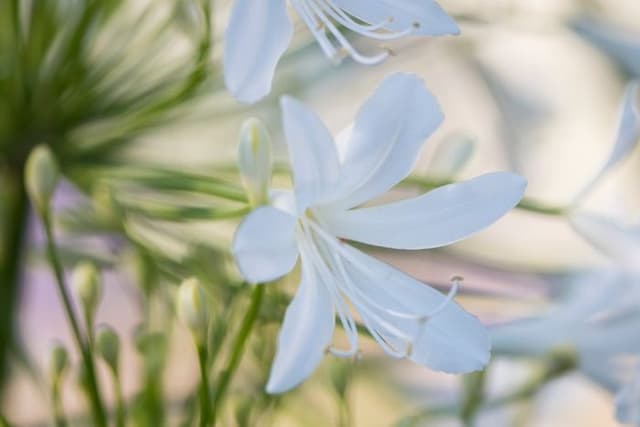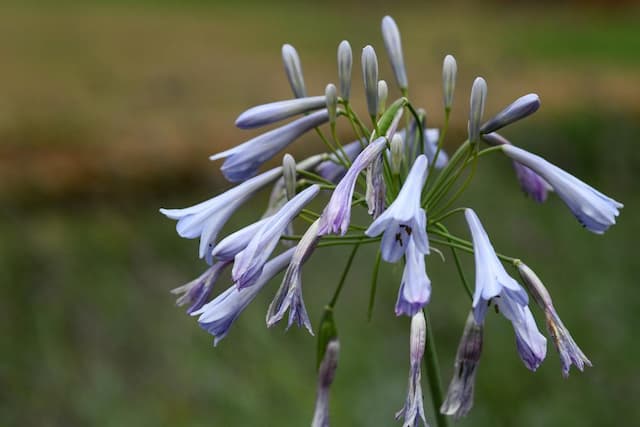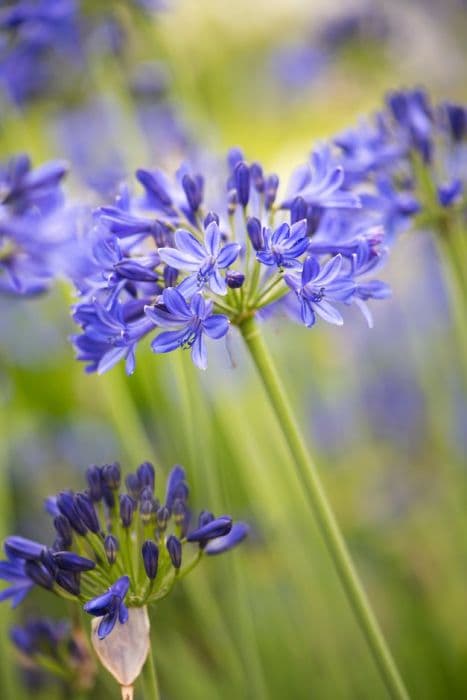Lily of the Nile Agapanthus 'Streamline'

ABOUT
Agapanthus 'Streamline' is a striking and elegant plant, known commonly as the African Lily or Lily of the Nile. It showcases a clump-forming habit with strap-shaped, arching leaves that are rich green in color and create a lush, grassy base from which its blooms emerge. The most distinctive feature of this plant is its flowers; atop long, sturdy stalks, it boasts rounded clusters of bell-shaped, periwinkle blue to lavender flowers. Each cluster is a globular head comprising numerous small individual blooms with a gentle, trumpet-like form that adds a touch of delicate finesse. These blossoms typically appear during the warm months, providing a visual spectacle that attracts both admiration from onlookers and pollinators such as bees and butterflies to the garden.
About this plant
 Names
NamesFamily
Amaryllidaceae
Synonyms
African Lily, Lily of the Nile
Common names
Agapanthus 'Streamline'.
 Toxicity
ToxicityTo humans
Lily of the Nile, including the 'Streamline' variety, contains compounds that are potentially harmful if ingested by humans. While not considered highly toxic, it can cause gastrointestinal symptoms such as nausea, vomiting, and diarrhea if parts of the plant are consumed. There is also the potential for allergic skin reactions from contact with the sap. It's important to handle Lily of the Nile with care and to avoid ingesting any part of the plant.
To pets
Lily of the Nile is toxic to both cats and dogs. If a pet consumes parts of this plant, they can experience symptoms including vomiting, diarrhea, nausea, abdominal pain, and drooling. In severe cases, it could lead to tremors or cardiac arrhythmia. If you suspect your pet has ingested Lily of the Nile, you should contact a veterinarian immediately. It's crucial to ensure that pets do not have access to chew or ingest any part of this plant.
 Characteristics
CharacteristicsLife cycle
Perennials
Foliage type
Evergreen
Color of leaves
Green
Flower color
Blue
Height
2 feet [0.61 meters]
Spread
2 feet [0.61 meters]
Plant type
Bulb
Hardiness zones
8
Native area
South Africa
Benefits
 General Benefits
General Benefits- Low Maintenance: Agapanthus 'Streamline' is easy to care for and does not require frequent watering or fertilizing.
- Drought Tolerant: Once established, it is very tolerant to dry conditions, making it ideal for xeriscaping or low-water gardens.
- Long Blooming: It produces flowers over a long period, often from early summer until the first frost, providing a long season of visual interest.
- Attracts Wildlife: The flowers attract pollinators such as bees and butterflies, adding to the biodiversity of the garden.
- Landscape Versatility: Suitable for borders, containers, and mass planting, providing flexibility in garden design.
- Architectural Structure: With its strappy leaves and tall flower stalks, it adds shape and form to the garden.
- Color Variety: The blooms offer a range of colors, from deep blue to purple, which can complement a diverse palette in the landscape.
- Disease and Pest Resistance: It is typically resistant to common garden pests and diseases, minimizing the need for chemical treatments.
 Medical Properties
Medical PropertiesThis plant is not used for medical purposes.
 Air-purifying Qualities
Air-purifying QualitiesThis plant is not specifically known for air purifying qualities.
 Other Uses
Other Uses- Agapanthus, commonly known as Lily of the Nile, can be used in dried flower arrangements; when dried properly, the flower heads retain much of their shape and color, providing a long-lasting decorative element.
- The tall and sturdy flower stems of Lily of the Nile can be used as natural supports for other, more delicate plants in the garden, helping them to stay upright.
- In the garden, the dense clumps formed by Lily of the Nile can be used as a living mulch, suppressing weeds and helping to retain soil moisture.
- Lily of the Nile plants can be planted in large, communal pots as a security measure to deter trespassers with their thick, fleshy roots making it difficult to move the pots.
- The robust leaves of the Lily of the Nile can be used in creative arts and crafts, such as natural print-making or leaf painting, due to their texture and durability.
- The sap from Lily of the Nile, when applied carefully, can be used as a natural adhesive for small garden repairs or craft projects.
- The striking blue and purple flowers of the Lily of the Nile can be used as a natural dye source for paper, textiles, or crafts with proper treatment.
- The seed pods of Lily of the Nile, when dried, can be incorporated into musical instruments like shakers, adding a unique sound and aesthetic.
- The thick roots of the Lily of the Nile can be carved into garden ornaments or stamps for garden labeling, due to their pliable yet sturdy nature when fresh.
- During Halloween, the distinctive shapes of Lily of the Nile’s seed heads can be integrated into outdoor decorations to add an eerie, natural texture to the scenery.
Interesting Facts
 Feng Shui
Feng ShuiThe Lily of the Nile is not used in Feng Shui practice.
 Zodiac Sign Compitability
Zodiac Sign CompitabilityThe Lily of the Nile is not used in astrology practice.
 Plant Symbolism
Plant Symbolism- Love Letters: The name Agapanthus comes from the Greek words 'agape', meaning love, and 'anthos', meaning flower. Collectively it is often referred to symbolize 'love letters', suggesting a message or a token of affection.
- Beauty: This plant is widely admired for its beautiful clusters of blue or purple flowers and therefore is commonly associated with beauty and a pleasing appearance.
- Constancy and Endurance: Agapanthus, often known as the African Lily, is a hardy plant that persists through various conditions, which is why it has become a symbol for both constancy and endurance through life's challenges.
 Water
WaterThe Lily of the Nile should be watered deeply once a week, allowing the soil to dry out slightly between watering sessions. In the warmer months, this may translate to about one inch of water per week, either through rainfall or manual watering. During the growth season, it's crucial to provide consistent moisture without oversaturating the soil. Cut back on watering in the winter when the plant goes dormant, reducing the amount to half a gallon every other week, preventing the soil from becoming waterlogged.
 Light
LightLily of the Nile thrives best in full sun to partial shade. An ideal spot would be where the plant can receive at least six hours of direct sunlight each day. If grown indoors, a south-facing window is a good location, but make sure to protect the plant from harsh midday sun during the peak of summer.
 Temperature
TemperatureLily of the Nile prefers a temperate climate and does well between 60°F and 80°F. It can survive minimum temperatures down to 50°F and maximum temperatures up to about 90°F. However, prolonged exposure to temperatures outside this range, either cold or hot, can damage or stress the plant.
 Pruning
PruningPruning the Lily of the Nile is important for removing spent blooms and encouraging new growth. Deadhead the faded flowers throughout the blooming season and cut back the stems to the base in late fall or early winter after the plant has finished flowering. Every few years, you may also need to divide the clumps to prevent overcrowding and stimulate renewed vigor, ideally in the spring before the growing season begins.
 Cleaning
CleaningAs needed
 Soil
SoilLily of the Nile prefers well-draining soil with a pH of 6.0 to 8.0. A mixture of loam, sand, and compost will ensure good growth. Amending the soil with organic matter improves nutrient availability.
 Repotting
RepottingLily of the Nile should be repotted every 2-4 years, best done in the spring. It enjoys being somewhat root-bound, so only repot when necessary.
 Humidity & Misting
Humidity & MistingLily of the Nile thrives in moderate humidity levels, but is quite adaptable and does not require any special humidity considerations for growth.
 Suitable locations
Suitable locationsIndoor
Place Lily of the Nile in bright, indirect light and room temperature.
Outdoor
Plant Lily of the Nile in partial sun, shelter from harsh rays.
Hardiness zone
8-10 USDA
 Life cycle
Life cycleThe life cycle of the Agapanthus 'Streamline', commonly known as the African Lily, begins with seed germination, which occurs in warm, moist soil conditions. After germination, the seedling develops a root system and foliage leaves, progressing into a vegetative state where the focus is on growth and energy accumulation. As the plant matures, it enters the flowering stage, typically during the summer, producing tall stalks topped with clusters of trumpet-shaped flowers that attract pollinators. After pollination, the flowers give way to seed pods, which mature and eventually release seeds, completing the reproductive cycle. In regions with cold winters, the African Lily enters a dormancy period where growth slows or halts until favorable conditions return in the spring. Throughout its life, the plant will continue to expand by forming new clumps from the base, gradually increasing its size and floral display year after year if conditions are suitable.
 Propogation
PropogationPropogation time
Spring-Early Summer
Propogation: The most popular method of propagation for the Agapanthus 'Streamline', commonly known as the Lily of the Nile, is by division, which is best done in the spring or early fall. This involves carefully digging up the plant, ensuring a sizeable clump of roots and foliage remains intact for each division. It's recommended that each new section should have at least one fan of leaves and plenty of root to ensure a successful transplant. Using a sharp knife or a spade, the clump is divided into smaller sections, each with its own roots and shoots. These sections are then replanted at the same depth they were growing before, spaced about 18 inches (approximately 45.7 centimeters) apart to give them enough room to grow. After planting, it's essential to water the divisions thoroughly to help establish them in their new locations.







![African lily [Brilliant Blue]](/_next/image?url=https%3A%2F%2Fplants-admin.emdemapps.com%2Fimages%2Fplants%2F%2Fimages%2F604b5e3c28e2b.png&w=640&q=75)

